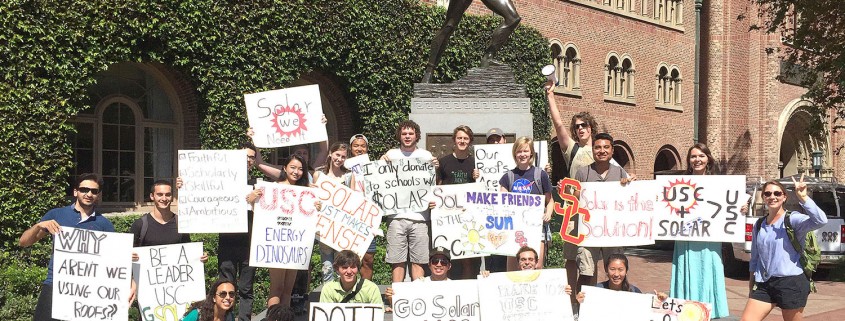Environmental Core hosts first solar rally
Standing in the shadow of the tower cranes working on the new Glorya Kaufman International Dance Center, junior Zach Manta pointed out how USC undertook a multi-million dollar construction project while the campus lacks basic renewable energy infrastructure.
“We have the technology to take advantage of solar energy — that makes sense,” said Manta, an environmental studies major. “Somehow, USC doesn’t think that it makes sense.”
USC’s Environmental Core held the University’s first ever solar rally, a public demonstration aimed at alerting the administration of the need to install solar panels on campus last Friday. Starting at 11 a.m., demonstrators convened in the University Religious Center courtyard to listen to speeches from Manta and faculty advisor Josh Goldstein.
Opening remarks by Goldstein, an associate professor of history and East Asian languages and cultures at Dornsife College of Letters, Arts and Sciences, emphasized that it’s the University’s responsibility to use its sizeable endowment for the good of the environment.
“Universities should be responsible for spending money and not just making money,” Goldstein said.
The group of 20 students and faculty members then marched down Trousdale Parkway before assembling around Tommy Trojan, holding signs proclaiming “Solar Just Makes Sense” and chanting slogans such as, “This is the hour for solar power.” The demonstrators then made their way to Bovard Auditorium, standing directly outside the office of President C. L. Max Nikias, where student organizer Ethan Bialick, a senior majoring in business administration, read aloud a letter to Nikias, urging the president to take action.
“Climate change is one of the largest and most complex problems in human history,” Bialick read. “As Provost Quick pointed out in his installation speech, USC is one of the ‘few institutions of higher education [that has] the breadth’ to address this problem in a significant way.”
The event, organized by Manta and Bialick, has been a year and a half in the making, according to Bialick. He and several other students began researching solar power, communicating with the Office of Sustainability and bringing in solar energy consultants in an attempt to understand what it would take for USC to implement solar power on campus.
“We did all the research, but we need USC to take action,” Bialick said. “We want to be meeting directly with the administration — we want to be working with them, not against them. We’ll keep pushing with bigger and bigger activism until we can actually talk about building a solar plan.”
The demonstrators aim to convince Nikias and other administrators to implement a system that would generate 10 percent of the University’s electricity from solar panels on campus by 2020. Currently, the University does not utilize solar power at all, a fact that event organizers contrasted with the solar power initiatives of schools such as Stanford, Harvard and UCLA. Bialick stressed the feasibility of switching 10 percent of the University’s electricity from fossil fuel to solar power sources, and highlighted the need for USC to take this initiative due to its prominence in the Los Angeles community.
“Ultimately, we will be able to displace some of the fossil fuels that we’re using right now with solar [energy], but I think the biggest impact is in showing that we’re a leader,” Bialick said. “It’s a message to the students, the staff [and] the faculty that this is reasonable [and] that it can happen because the University did it.”
Students taking part in the demonstration, including sophomore Roberto Perez, agreed with Bialick and Manta, stressing the need for USC to embrace sustainability.
“I think it’s ridiculous that USC has no solar power at all, so I think it’s about time for us to at least ask the administration to install solar panels,” Perez said. “I think it would be a good step forward, not only making USC more sustainable, but setting the example for other universities and for other businesses around the area.”
Eventually, students hope to see solar panels on buildings such as the Galen Center, the Lyon Center, the Carol Little Building and numerous parking structures around campus.

